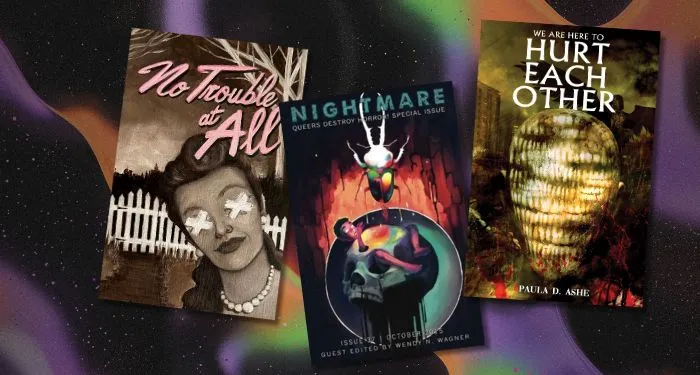What is “conservatism”? Just a word. There is no essence to “conservatism,” any more than there is to “liberalism,” or “the right,” or “the left.” These are labels we make for little boxes into which we drop things that seem related, for reasons we can’t always articulate and sometimes can’t even remember.
We can, as a post-facto exercise, try to discern what qualities are shared by the things we’ve gathered over the years, but it’s always a loose fit. And over time, as more things accumulate, we may find that it makes more sense to disaggregate the contents of the boxes and label them differently for a tighter fit. We are like the employees in the TV series Severance who stare all day at matrices of vibrating random numbers on computer screens until the moment when a set of numbers “feels” related and it can be slipped into a particular folder at the bottom of the screen.
In the Age of Trump, our ideological boxes are in bad need of rearranging. Over the past decade we have accumulated piles of unfamiliar ideas, passions, and movements, all linked through new means of communication and mobilization. Which boxes to put them in? Consider a new human type among us: the Silicon Valley tech bro who wants to cut taxes and end censorship of the Internet, dreams of post-human immortality, belongs to a reading group studying Leo Strauss, listens to Peter Thiel’s lectures on the Antichrist, and posts anonymous misogynistic rants on 4chan. Is he a libertarian? A liberal? A conservative? A reactionary? He would probably call himself a revolutionary, though to what end he seems not to have considered.
But it is the box labeled “conservative” that most needs our attention today. It was only after World War II that certain American thinkers and politicians on the right began to gather self-consciously under that rubric and develop for themselves a genealogy that supposedly ran continuously from Edmund Burke to William F. Buckley.1 This epos was first set down by a then obscure scholar based in rural Michigan, Russell Kirk, in his influential study The Conservative Mind (1953) and later in his capacious anthology The Portable Conservative Reader (1982). What held this ideological family together, according to Kirk, was not consanguinity or adherence to a particular church. It was a set of principles: limited constitutional government, local control, incremental social change, respect for tradition and religious piety, and suspicion of empire building.
From the mid-1950s through the Reagan administration there was, then, a box in which ideas, thinkers, and movements declaring themselves in line with those principles were stored by both self-declared conservatives and those who studied them. But from the start countless other artifacts that would not have passed Kirk’s litmus test kept getting dropped in. First there was the legacy of Joseph McCarthy and the Cold War policies that led to foreign entanglements on virtually every continent. Soon laissez-faire economics, the great destroyer of traditional institutions and temperamental moderation, was baptized a part of “fusion” conservatism, preparing the way for supposed local control purists to shill for a global financial system that since the 1980s has laid waste to Main Streets from coast to coast. Half a century later wars in Iraq and Afghanistan were promoted by neoconservatives who made a mockery of Burke’s advocacy of prudent statesmanship. By 2016 no one on the right really knew what “conservatism” meant anymore. The bottom of the conceptual box gave way, and now we are left to sort it all out.
All this is fairly obvious, and we certainly have our hands full coping with the aftermath. But as a historical matter, how are we to understand how we got here? Three interpretations have been suggested so far. One is that MAGA is the apotheosis of the conservative movement, revealing what has always been at its core: greed, cruelty, irrationality, racism. Another is that MAGA is a betrayal of conservativism, which only proves the necessity of combating Trumpism and restoring the intellectual tradition. Another still is that this belief in the continuity of a conservative tradition blinded the mainstream moderate right to the growing number of nihilistic, apocalyptic fanatics in their midst who had no interest in conserving anything, only in staging a counterrevolution against the Sixties, against liberalism, against moderation, against pluralism, against even democracy itself. On this view, the MAGA right is fed not by conservative ideas but by chthonic forces in human nature that at different points in history gather like a hurricane and can level any decent political order. Two recent books pursue this last thesis, with convincing results.
John Ganz’s When the Clock Broke changed my mind about many things. As someone who joined the staff of the neoconservative public policy magazine The Public Interest a few months before Ronald Reagan was first elected, I found it easy at the time to look at the previous forty years of American politics as a “preparation of the Gospel,” to borrow Eusebius’s phrase. By the end of the decade a healthy convergence did indeed seem to be taking place between a chastened liberalism among educated elites and a temperate conservatism among the mainly white Republican electorate. The fall of the Berlin Wall followed by the election of the moderate liberal Bill Clinton seemed to augur a new age of consensus and equilibrium in American politics. It was this kind of thinking that led many neoconservatives of my generation, most notably Francis Fukuyama, to think that the drawn-out historical drama in the West running from 1789 to 1989 had reached its terminus. Not that history as such was over (Fukuyama never said that, so please get off his back), but at least this two-century struggle over the best political order was.
Today it is this progressive epos that has reached its end, for reasons obvious and not so obvious. As Ganz shows, it did not account for the emergence in the 1990s of a small band of idiosyncratic “paleoconservatives” who harked back to the isolationism and nativism of the pre-war America First movement. These populist paleos rallied around figures like the Nixon crony Pat Buchanan and the radio shock jock Rush Limbaugh, who in 1988 began his hugely influential talk show, which spawned many imitators. Still, even by early 2016 the moderate liberal Hillary Clinton and the moderate conservative Jeb Bush appeared to be leading contenders for their parties’ presidential nominations, and the paleos seemed to be outliers, yesterday’s news. I recall meeting a well-known French TV journalist at the time who interviewed me for a book on the new great dynasties of American politics, the Clintons and the Bushes. The drinks were free and we spoke long into the night. I blush to recall it.
And of course we were not just a little wrong about the election’s outcome. We were wildly, thickheadedly, extravagantly, cluelessly, retchingly wrong about some of the deepest intellectual and cultural currents that had been surging through American society over the previous three decades. Ganz forces his liberal and conservative readers to confront everything they preferred not to see at the time.
He begins in an unpromising place: the victory of the former grand wizard of the Ku Klux Klan David Duke in a Louisiana state legislature primary in January 1989, the day after George H.W. Bush’s inauguration. When I read this in the first paragraph of the book I nearly tossed it across the room. Yes, yes, conservatives are all Nazis. Oh, please… But that is not Ganz’s point at all. Rather, he sees in Duke’s increasing popularity in the 1990s the first expression of the white working-class anger against both major parties that had been growing steadily throughout the 1980s, as the nation was piling up debt and the economy was undergoing financialization. Warning flares were being sent up on the other end of the spectrum, too, by left communitarian figures like Christopher Lasch, to little effect. Duke’s short-lived mainstreaming in the years that followed—he made national TV appearances on the Phil Donahue and Larry King shows—had real significance for reasons not obvious at the time. As the writer Walker Percy presciently told The New York Times in 1989:
Don’t make the mistake of thinking David Duke is a unique phenomenon confined to Louisiana rednecks and yahoos…. Don’t think that he or somebody like him won’t appeal to the white middle class of Chicago or Queens.
Ganz calls Duke a “swamp creature” not because he came from Louisiana but because he did indeed seem to emerge from the old right’s antediluvian past of the 1920s and 1930s.
The best barometer of this climate change was Sam T. Francis, a strange-looking, sharp-tongued southern journalist. Described even by friendly conservatives as a “fearsome toad” and “alarmingly well fed,” he was also filled to bursting with resentment against northerners, Ivy Leaguers, and hypocritical moralizing liberals, all of whom received sharp and sometimes quite funny lashings in his essays. Francis was born in Tennessee in 1947, and after getting a Ph.D. in history at the University of North Carolina he worked on Capitol Hill and for the Heritage Foundation before becoming a popular columnist at the Moonie-owned newspaper The Washington Times. He spent nearly a decade there writing editorials and columns, even winning the American Society of Newspaper Editors’ Distinguished Writing Award for Editorial Writing two years in a row, before being fired in 1995 for making outrageous white supremacist comments at a conference. Outed, Francis spent the last few years of his life editing a white supremacist quarterly and writing for journals that seemed marginal at the time but in retrospect helped to prepare our contemporary drama.
Francis’s enduring influence on the paleo right has had less to do with his racism—which is increasingly blatant on the MAGA right—than with his weaponization of the ideas of James Burnham, one of the most unusual American political thinkers of the twentieth century. As a young NYU philosophy professor during the Depression, Burnham was an active Trotskyist who eventually broke with his mentor in 1940 over conditions in the USSR, prompting the old revolutionary to publish a famous and highly critical “Open Letter to Comrade Burnham” months before his assassination. Burnham’s full position was then spelled out in his book The Managerial Revolution (1941), which had a wide readership at the time and left a deep mark on George Orwell’s thinking about totalitarianism. Burnham’s argument was that beneath the superficial differences between FDR’s New Deal, Soviet communism, and even Nazism, there was in all these modern regimes the looming threat of totalitarian domination by managerial elites motivated solely by the desire to extend their own power. This, Burnham argued against Trotsky, was what had happened in Stalin’s Russia: the old regime had been overthrown, but the workers did not rule, the party apparatchiks did. Burnham thought the development of managerial elites was inevitable, given the modern industrial economy and complex state bureaucracies, but their power needed to be constrained. After World War II, with the forced spread of communism in Eastern Europe, Burnham became a hawk arguing for an aggressive policy of rollback against the Soviet Union and, later, Communist movements around the world. When National Review was founded in 1955, he joined the staff as a senior editor.
Burnham was not a populist and harbored no fantasies of a world without competent, educated elites. Sam Francis did. He thought he had found in The Managerial Revolution the inspiration for a counterrevolution from below by what he aptly called the “white post-bourgeois middle classes,” who were being steadily proletarianized by economic and cultural elites who had contempt for them. The counterrevolution would first be directed at the conservative elites of the Republican Party and in particular the Jewish neoconservatives, whose alleged dual loyalties had gotten America sucked into global conflicts that distracted attention from challenges at home.
Francis wanted open political and cultural war, writing that “the New Right is not a conservative force but a radical or revolutionary one” and “the first thing we have to learn about fighting and winning a cultural war is that we are not fighting to conserve something; we are fighting to overthrow something.” To lead such a movement, he imagined a new, populist Caesar: “The New Right will favor a populist-based presidency able to cut through the present oligarchical establishment…which is a parasitical tumor on the body of Middle America.” Francis died in 2005, a decade before he could have seen just how prescient he had been.
In Ganz’s telling, the unsuccessful presidential campaigns of Pat Buchanan in the 1990s were dry runs for the battle to come. Buchanan’s ally Murray Rothbard gave fiery speeches on his behalf, stirring up crowds by crowing, “Yes, the status anxious, paranoid, deeply resentful, radical Right is back” and “We shall repeal the twentieth century!” Buchanan went one step further, writing in The Washington Times that “if communism was the god that failed the Lost Generation, democracy, as ideal form of government, panacea for mankind’s ills, hope of the world, may prove the Golden Calf to this generation.” His presidential campaigns failed, but thanks to them militant paleoconservatism remained potent on the right, to the point that the conservatism of Kirk and Buckley no longer resonated with average Republican voters, only with the party elite, who were as stunned by Donald Trump’s victory in 2016 as liberals were. A new, apocalyptic outlook had taken shape, and its inner confusions proved part of the appeal. Ganz captures perfectly the weirdness of it all:
In the paleo junk shop of discarded historical forms, the dour Puritan Roundhead made a strange peace with the chivalrous Southern cavalier. Their imagination resembles nothing so much as the rainy-day transports of a boy who lines up all his toy soldiers from different periods in a grand alliance—here’s a knight, there’s a cowboy, here’s Davy Crockett, there’s a Special Forces commando. And for all its eclectic-yet-selective evocations of white civilizational virtue, the movement’s sentimentalism and romance was also steeped in Spenglerian gloom: the writing of this cohort of paleo thinkers is shot through with a deep cynicism, even nihilism, and a hard-hearted notion of power that questions democracy itself.
One could mistake this for a description of Trump’s current cabinet.
Ganz brings his narrative to a close in 1992 with Bill Clinton’s defeat of George H.W. Bush, which represented the end of the Reagan era. For liberals this was a welcome event, though it had the unfortunate consequence of lowering their guard and keeping them from taking seriously enough the populist passions that continued to grow over the next two decades and the ways in which cable news and the new social media were stoking them. Even less were liberals aware of the rise of a new intellectual class on the right that had no affiliation with Buckleyan conservatism or neoconservatism and was eager to exploit those passions.
Laura Field’s Furious Minds is the most up-to-date introduction we have to the MAGA intellectual right reshaping America with astonishing speed today. She devotes a thorough chapter to the Catholic postliberals2 and another to the Christian nationalists aiming to homeschool their way to a new America. She is particularly good on the less well known National Conservatives, an increasingly powerful group with a global reach that rejects liberal internationalism and looks with admiration to Viktor Orbán’s Hungary and the Likud Party’s Israel as models of civic health. And over several chapters she also gives us a paddleboat tour of the Internet cesspool of alt-right neoreactionaries who, under slogans like “accelerationism” and “dark enlightenment,” promote the hastening of social and economic apocalypse to clear the way for a postdemocratic techno-state ruled by misogynistic strongmen.
But the most interesting chapters are those that Field devotes to a sect of Leo Strauss admirers at the Claremont Institute in California, which has become the most radical and disciplined intellectual force on the MAGA right. The institute, which has no official connection with the Claremont Colleges, was founded in 1979 by followers of Harry Jaffa, an eccentric early student of Strauss’s who in the wider world was mainly known for two things: a seminal study of the Lincoln–Douglas debates (Crisis of the House Divided, 1959) and a convention speech he wrote for Barry Goldwater in 1964 that included the disastrous line “Extremism in defense of liberty is no vice,” which the LBJ campaign successfully exploited to portray Goldwater as a dangerous lunatic. Less remembered is the following sentence of the speech—“Moderation in pursuit of justice is no virtue”—which would soon prove very much in the activist spirit of the 1960s. Jaffa wasn’t really a conservative at all; he believed in the existence of universal natural rights and natural human equality, as did the authors of the Declaration of Independence, he reminded his readers. America in his view was primarily a creedal nation with a mission promulgated in the Declaration, not a pragmatic constitutional republic like those to be found at different moments in Western history. Jaffa was in equal measure a Straussian Platonist and a red-white-and-blue Jacobin who just happened to write for National Review.
Field has a privileged perch from which to report on the Claremont Institute, having been trained academically by Straussians, and she carefully follows its development into the intellectual nerve center of the New Right. Until the 2010s it was considered one of the mainline conservative think tanks on the Republican side, and its outsize influence was mainly owing to the number of summer programs in classic political texts it ran over the years for high school and college students. Former fellows can be found throughout the Trump administration as well as in the Senate (Tom Cotton) and in right-wing media (Laura Ingraham, Ben Shapiro, Mark Levin, Dinesh D’Souza). But in the last fifteen years the tone of the institute’s work has become increasingly apocalyptic and impatient for action. Field points to the significance of a short-lived online journal started by Claremont affiliates with the unironic title Journal of American Greatness. One of its contributors was a recent director of policy planning in the Trump White House, Michael Anton, who just before the 2016 election wrote an unhinged online article channeling Jaffa’s radicalism that began:
2016 is the Flight 93 election: charge the cockpit or you die. You may die anyway. You—or the leader of your party—may make it into the cockpit and not know how to fly or land the plane. There are no guarantees. Except one: if you don’t try, death is certain. To compound the metaphor: a Hillary Clinton presidency is Russian Roulette with a semi-auto. With Trump, at least you can spin the cylinder and take your chances. To ordinary conservative ears, this sounds histrionic.3
And not just to those ears.
The article, which was promoted by Rush Limbaugh, ricocheted across the Internet, and according to Field it marked the moment when a number of seemingly conservative Straussians shed their rhetorical moderation and came out as full-throated MAGA populists. Why they fell for Trump, of all people, still needs explaining. The twentieth-century statesman whom Strauss and his earliest students professed to admire most was Winston Churchill, and the lipstick that could make our current president resemble him has yet to be invented. But over the past decades, beginning with the publication of Allan Bloom’s best seller The Closing of the American Mind in 1987, a mood of cultural apocalypticism wholly alien to Churchill has colored ever more darkly the Straussians’ ruminations about contemporary America and the destiny of “the West.” Apocalypticism has the capacity to rewire the brains of even the most reflective individuals and distort their vision to such a degree that even a bullying plutocrat with a deep fake tan can appear as the Messiah. The yearning for a national savior is enough to make you forget all about Plato, Aristotle, and the American Framers.
In any case, after Anton’s Flight 93 article appeared the red hats were donned in Claremont, and everyone is still wearing them around the agora. In the run-up to the 2020 election, when Trump’s prospects were uncertain, the institute was deeply involved in spreading lies about a planned Biden coup and then laying out plans for overturning the election, or at least having Mike Pence prevent its certification in Congress. The lead figure here was the director of the institute’s Center for Constitutional Jurisprudence, John Eastman, who was disbarred by the State of California and indicted in Georgia on racketeering charges and in Arizona on racketeering, conspiracy, and fraud charges for his efforts, and who shows up at least five hundred times in the January 6 Committee’s final report.
After Biden’s victory the new Trumpian intellectuals found themselves in possession of their own useful historical epos that began with the Flight 93 election and ran up to the failed January 6 rebellion that was to become the new Lost Cause. They spent the next four years in noisy, hyperconnected exile working toward the return of the Hidden Imam of Mar-a-Lago, who would then set about settling scores, real and imagined. And it wouldn’t stop there, if Anton had anything to do with it. In 2020 he wrote a pre-election polemic, The Stakes: America at the Point of No Return, that was conventional except for one chapter in which he imagined a possible postdemocratic future for the United States. After clearing his throat by declaring, “My fondest political dream is for a restoration of the American constitutional order,” he then shifts to a just spitballing here style and imagines a scenario in which American society would become even more polarized between red states and blue states, with the ruling “managerial class”—which dominates the media, the universities, Hollywood, Washington, and “woke capitalist” boardrooms across the country—progressively centralizing all power into its hands. “In the present, divided America there is not one multitude but two: one blue, the other red. Yet there’s only one ruling class, to which the blue multitude is allied.” Tip of the hat to Sam Francis.
How might red America respond to this velvet coup d’état? Could red states secede, with blue states happy to see them go? Or would there be another civil war? If so, which side would the armed forces be on? Probably, and it seems unfortunately in Anton’s view, they would obey the oath they took to support and defend the Constitution. But that would not exhaust all the options for saving America. We need at least to consider the possibility (another Anton spitball flies) that in that decisive moment an American Caesar could arise in our midst, engender calm, hold the country together, and defend the national interest, if only to selfishly perpetuate his rule. If the courts ruled against the nation’s savior, “Caesar’s contemptuous reply to the courts would echo Andrew Jackson’s: you’ve made your ruling, now let’s see you enforce it.” And if the military got cold feet, “it is possible that red Caesar could win over the majority of law enforcement to his side.”
The Claremont Institute seems to have taken Anton’s reverie seriously. A few years ago it established a Sheriffs Fellowship, which offers room, board, travel, and a $1,500 honorarium to selected sheriffs who gather to
discuss the political-philosophical, institutional, and historical arc leading from the American Founding to today’s militant progressivism and multiculturalism, with particular emphasis on the role of law enforcement in maintaining liberty.
Topics of discussion listed on the webpage include the Federalist Papers, “Natural Rights and Natural Law,” and, at the very end, “The Roots of Radical Leftist Ideology.”
The intellectual pedigrees of the groups Laura Field profiles—the Claremont Straussians, the America First paleoconservatives, the Catholic postliberals, the Christian nationalists, the Peter Thiel techno-futurists, the manosphere meatheads—appear superficially different. Yet here they all are, settled quite comfortably in a new box for which we have no label so far other than “Trumpian.” Readers of these two insightful books should see that the exercise of determining what these groups share more deeply and which boxes they ultimately belong in would not be an idle academic one. John Ganz thinks that “fascism” is the word our Sharpies should be writing on the label. I’m not so sure. But if so, that would only take us back to debates that preoccupied us throughout the last century. Were fascism and communism just “extreme” versions of conservatism and liberalism, and thus at opposite poles of the ideological spectrum? Or were they instead coeval emanations of a violent cultural storm front that swept across the West, laying waste to the achievements of centuries? And are we about to face a new one?
Just listen to the thunder. We are the storm. And our enemies cannot comprehend our strength, our determination, our resolve, our passion…. You have nothing. You are nothing. You are wickedness, you are jealousy, you are envy, you are hatred. You are nothing…. You have no idea the dragon you have awakened.4


















 English (US) ·
English (US) ·